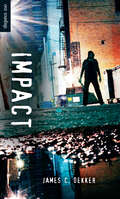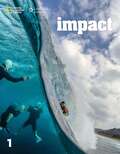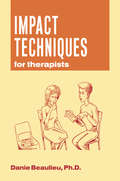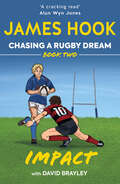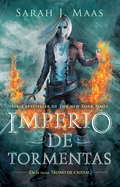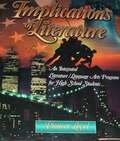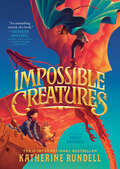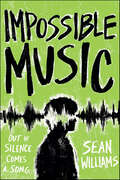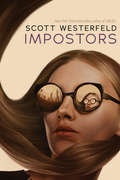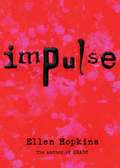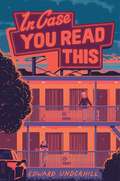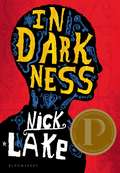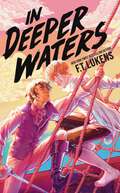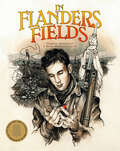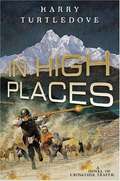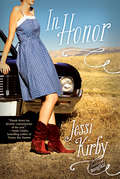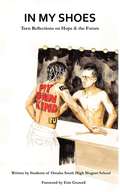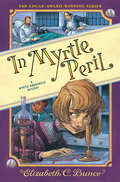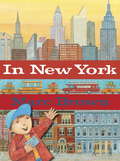- Table View
- List View
Imogen, Obviously
by Becky AlbertalliA Stonewall Honor Book · A New York Times and Indie bestseller!“A bighearted, deeply vulnerable, love-bubbly tumble through self-discovery.” —Casey McQuiston, author of the #1 New York Times bestselling I Kissed Shara WheelerWith humor and insight, #1 New York Times bestseller Becky Albertalli explores the nuances of sexuality, identity, and friendship in this timely new novel.Imogen Scott may be hopelessly heterosexual, but she’s got the World’s Greatest Ally title locked down.She's never missed a Pride Alliance meeting. She knows more about queer media discourse than her very queer little sister. She even has two queer best friends. There's Gretchen, a fellow high school senior, who helps keep Imogen's biases in check. And then there's Lili—newly out and newly thriving with a cool new squad of queer college friends.Imogen's thrilled for Lili. Any ally would be. And now that she's finally visiting Lili on campus, she's bringing her ally A game. Any support Lili needs, Imogen's all in.Even if that means bending the truth, just a little.Like when Lili drops a tiny queer bombshell: She's told all her college friends that Imogen and Lili used to date. And none of them know that Imogen is a raging hetero—not even Lili’s best friend, Tessa.Of course, the more time Imogen spends with chaotic, freckle-faced Tessa, the more she starts to wonder if her truth was ever all that straight to begin with. . . .
Impact (Orca Soundings)
by James DekkerJordan's brother was killed two years ago in what appeared to be a random act. Now, as the family reads their impact statements in court before the suspect is sentenced, a different story emerges. Maybe this was not a random act. Maybe Jordan knows more than he is saying. What was the impact of that violent act? And who set the wheels in motion?
Impact Techniques for Therapists: 88 Activities To Engage Your Students
by Danie BeaulieuImpact Techniques for Therapists teaches the basic principles of Impact Therapy, first developed by Ed Jacobs in 1992. Drawing heavily on the work of Milton Erickson, this form of therapy uses a creative and interactive approach to counseling that involves all senses in the therapeutic process. These innovative, multisensory techniques will incorporate therapist-client exchanges on not only verbal but also visual and kinesthetic levels, thereby increasing the efficacy of the intervention. Accompanied by a conversational tone and vivid artwork, Beaulieu presents concrete examples of props and movements that can be introduced into therapy and thoroughly illustrates their different uses. Originally written and published in French as a handbook for therapists, Dr. Beaulieu’s formative work is now available in a new English edition, with a more encompassing introduction as well as updated case examples. The model set forth in this book can be integrated easily and seamlessly into the practice of a wide variety of mental health professionals seeking to discover new and innovative developments in brief therapy.
Impact: Chasing a Rugby Dream, Book Two
by James Hook David BrayleyA portrayal of a young person following their dream in the game, a cracking read' – Alun Wyn Jones, Wales and the British & Irish Lions Jimmy Joseph is enjoying a long, hot summer with his friends, counting down the days until he attends his first ever training camp at the Eagles Academy, the youth section of his local pro club. He hopes this is going to be the first major step on his journey to being a professional rugby player ... but a heavy tackle in training and cruel behaviour from his nemesis, Mr Kane, leads to Jimmy suffering a complete loss of confidence. How can he ever regain his love of the game – and fulfil his rugby dreams – if he is too afraid to tackle? In this new rugby adventure for Jimmy and his friends, James Hook and David Brayley examine concussion, tackling, friendship, loyalty and the true bravery that’s needed to overcome your fears.
Imperio de tormentas (Trono de Cristal #5)
by Sarah J. MaasEl viaje del hada Aelin de asesina a reina ha cautivado a millones en todo el mundo, y esta quinta entrega de la aclamada serie bestseller de The New York Times, Trono de cristal, dejará sin aliento a sus lectores. ¿Logrará Aelin evitar que su mundo se resquebraje o esto marcará el fin de todo? Quinta parte de un apasionante viaje épico que se ha publicado en una decena de países, repleto de emocionantes episodios de acción e intriga, aventuras, fantásticos personajes y los infaltables pasajes de amor y drama. El largo camino al trono apenas comienza para Aelin Galathynius. Se han roto y se han comprado lealtades, se han ganado y perdido amistades y quienes poseen magia se enfrentan a quienes no. Con todos los reinos de Erilea fracturándose a su alrededor, Aelin debe convertir a los enemigos en aliados si quiere evitar que sus seres amados caigan víctimas de las fuerzas oscuras que están listas para reclamar su mundo. Con la guerra al acecho en todos los horizontes, la única posibilidad de salvación se encuentra en una misión desesperada que podría marcar el fin de todo lo que Aelin ama en la vida. Un universo al nivel de los mundos planteados en Game of Thrones y Hunger Games.
Implications Of Literature: Pioneer Level
by Deborah SchechterReadings in the American Experience An Integrated Literature / Language Arts Program for High School Students
Implications of Literature, Trailblazer Level: An Integrated Literature/Language Arts Program for High School Students (Student Edition)
by TextWord Press StaffThis publication of the Trailblazer Level of the Implications of Literature Anthology Series marks the completion of the TextWord Press four-year literature series for high-school students. This fourth volume in the series surveys approximately 1500 years of English Literature. In this text you will come to understand how the English that we speak so comfortably today developed from Old English--a language that today is incomprehensible to almost everyone but scholars.
Impossible (Orca Soundings)
by Jocelyn ShipleySeventeen-year-old Jemma's older brother took her in when she needed to get away from her abusive ex-boyfriend, Razor. All Jemma wants now is to be a good mom to her baby daughter, Violet. But one night she needs to go out, just for a few minutes, to get diapers and ice cream. On her way back, she witnesses the drive-by shooting of a kid, Kwame, who lives in the same building. The driver is Razor. Jemma is terrified. If she tells anyone what she saw, they'll know she left her baby alone and she might lose custody. But if she doesn't, Kwame's killer will go free. Razor convinces Jemma to make a deal to save her life, but Jemma isn't sure she can live with the consequences.
Impossible Creatures (Impossible Creatures #1)
by Katherine Rundell#1 NEW YORK TIMES BESTSELLER • Two kids race to save the world&’s last magical place in the first book of a landmark new fantasy series, from &“a writer with an utterly distinctive voice and a wild imagination.&” (Philip Pullman, author of The Golden Compass) &“An instant classic from one of the most gifted storytellers of our time, Impossible Creatures is an astonishing miracle of a book.&” —Katherine Applegate, Newbery Medal Winner for The One and Only IvanA WALL STREET JOURNAL BEST CHILDREN'S BOOK OF THE YEAR • A PUBLISHERS WEEKLY, KIRKUS REVIEWS, AND SHELF AWARENESS BEST BOOK OF THE YEARThe day that Christopher saved a drowning baby griffin from a hidden lake would change his life forever. It&’s the day he learned about the Archipelago—a cluster of unmapped islands where magical creatures of every kind have thrived for thousands of years, until now. And it&’s the day he met Mal—a girl on the run, in desperate need of his help.Mal and Christopher embark on a wild adventure, racing from island to island, searching for someone who can explain why the magic is fading and why magical creatures are suddenly dying. They consult sphinxes, battle kraken, and negotiate with dragons. But the closer they get to the dark truth of what&’s happening, the clearer it becomes: no one else can fix this. If the Archipelago is to be saved, Mal and Christopher will have to do it themselves.Katherine Rundell&’s story crackles and roars with energy and delight. It is brought vividly to life with more than 60 illustrations, including a map and a bestiary of magical creatures.
Impossible Music
by Sean WilliamsIn an emotionally compelling tale crackling with originality, when a teen musician goes deaf, his quest to create an entirely new form of music brings him to a deeper understanding of his relationship to the hearing world, of himself, and of the girl he meets along the way. Music is Simon&’s life—which is why he is devastated when a stroke destroys his hearing. He resists attempts to help him adjust to his new state, refusing to be counseled, refusing to learn sign-language, refusing to have anything to do with Deaf culture. Refusing, that is, until he meets G, a tough-as-nails girl dealing with her own newly-experienced deafness. In an emotionally engaging tale crackling with originality, Simon's quest to create an entirely new form of music forces him into a deeper understanding of his relationship to the hearing world, of himself, and of the girl he meets along the way.
Impostors (Impostors #1)
by Scott WesterfeldDeception. Risk. Betrayal. Redemption. Master storyteller Scott Westerfeld is at the top of his game, and back to his most famous realm.Frey and Rafi are inseparable . . . two edges of the same knife. But only one of them is ever seen in public.Frey is Rafi's twin sister-and her body double. Their powerful father has many enemies, and the world has grown dangerous as the old order falls apart. So while Rafi was raised to be the perfect daughter, Frey has been taught to kill. Her only purpose is to protect her sister, to sacrifice herself for Rafi if she must. When her father sends Frey in Rafi's place as collateral in a precarious deal, she becomes the perfect impostor. But Col, the son of a rival leader, is getting close enough to spot the killer inside her . . . .
Impulse
by Ellen HopkinsFrom the bestselling author of Crank, the story of three kids whose lives collide at a mental hospital after each attempts suicide.Sometimes you don't wake up. But if you happen to, you know things will never be the same. Three lives, three different paths to the same destination: Aspen Springs, a psychiatric hospital for those who have attempted the ultimate act—suicide. Vanessa is beautiful and smart, but her secrets keep her answering the call of the blade. Tony, after suffering a painful childhood, can only find peace through pills. And Conner, outwardly, has the perfect life. But dig a little deeper and find a boy who is in constant battle with his parents, his life, himself. In one instant each of these young people decided enough was enough. They grabbed the blade, the bottle, the gun—and tried to end it all. Now they have a second chance, and just maybe, with each other's help, they can find their way to a better life—but only if they're strong and can fight the demons that brought them here in the first place.
In Case You Missed It
by Sarah Darer LittmanSometimes the only way to find yourself is to lose your privacy.Sammy Wallach has epic plans for the end of junior year over: Sneak out to the city to see her favorite band. Get crush-worthy Jamie Moss to ask her to prom. Rock all exams (APs and driver's).With a few white lies, some killer flirting, and tons of practice, Sammy's got things covered. That is, until the bank her dad works for is attacked by hacktivists who manage to steal everything in the Wallach family's private cloud, including Sammy's entire digital life. Literally the whole world has access to her emails, texts, photos, and, worst of all, journal.Life. Is. Over.Now Sammy's best friends are furious about things she wrote, Jamie thinks she's desperate, and she can barely show her face at school. Plus, her parents know all the rules she broke. But Sammy's not the only one with secrets -- her family has a few of its own that could change everything. And while the truth might set you free, no one said it was going to be painless. Or in Sammy's case, private.
In Case You Read This
by Edward UnderhillFrom acclaimed author Edward Underhill comes a trans rom-com about serendipity, chance encounter, and the ultimate missed connection. This joyful celebration of queer love and found family is perfect for fans of Becky Albertalli, Emery Lee, and Julian Winters.Arden isn’t excited about moving. Los Angeles was an easy place to fit in and find a supportive queer community. But Winifred, Michigan? That sounds like a much more difficult place to exist.Pasadena, California, is the perfect city for Gabe’s reinvention. Everyone knew everything about him in small-town Shelby, Illinois. Gabe, who wants to be out and proud, can’t wait to relocate.When Arden and Gabe randomly meet in the lobby of a motel in Nebraska, it feels like fate. Both are trans, but more importantly, both are huge fans of the band Damaged Pixie Dream Boi. Clearly, the universe is trying to tell them something. Right?But after an incredible evening of hanging out, the pair part ways only knowing the other’s first name. And as both boys struggle to adjust to their new homes, their thoughts keep being drawn back to their time together. Is one perfect night enough to bring Arden and Gabe back to each other, or will the boys need some help to find each other again?
In Darkness
by Nick Lake<P>This is the story of "Shorty"-a 15-year-old boy trapped in a collapsed hospital during the earthquake in Haiti. <P>Surrounded by the bodies of the dead, increasingly weak from lack of food and water, Shorty begins to hallucinate. <P>As he waits in darkness for a rescue that may never come, a mystical bridge seems to emerge between him and Haitian leader Toussaint L'Ouverture, uniting the two in their darkest suffering-and their hope.<P> A modern teen and a black slave, separated by hundreds of years. <P>Yet in some strange way, the boy in the ruins of Port au Prince and the man who led the struggle for Haiti's independence might well be one and the same... <P><b>Winner of the 2013 Michael L. Printz Award</b>
In Deeper Waters
by F.T. Lukens&“A frothy confection of sea-foam, young love, and derring-do.&” —NPR From the New York Times bestselling author of So This Is Ever After, a young prince must rely on a mysterious stranger to save him when he is kidnapped during his coming-of-age tour in this swoony adventure that is The Gentleman&’s Guide to Vice and Virtue meets Pirates of the Caribbean.Prince Tal has long awaited his coming-of-age tour. After spending most of his life cloistered behind palace walls as he learns to keep his forbidden magic secret, he can finally see his family&’s kingdom for the first time. His first taste of adventure comes just two days into the journey, when their crew discovers a mysterious prisoner on a burning derelict vessel. Tasked with watching over the prisoner, Tal is surprised to feel an intense connection with the roguish Athlen. So when Athlen leaps overboard and disappears, Tal feels responsible and heartbroken, knowing Athlen could not have survived in the open ocean. That is, until Tal runs into Athlen days later on dry land, very much alive, and as charming—and secretive—as ever. But before they can pursue anything further, Tal is kidnapped by pirates and held ransom in a plot to reveal his rumored powers and instigate a war. Tal must escape if he hopes to save his family and the kingdom. And Athlen might just be his only hope…
In Flanders Fields
by Norman JorgensenAn eloquent counterpoint to the senselessness and inhumanity of war, In Flanders Fields tells the story of a young homesick World War I soldier who risks his life to cross the no-man's-land and rescue a robin caught in the barbed wire that separates the opposing forces.
In High Places (Crosstime Traffic, book #3)
by Harry TurtledoveIn the twenty-first- century kingdom of Versailles, roads are terrible and Paris is a dirty little town. Serfdom and slavery are both common, and no one thinks that's wrong. Why should they? Most people spend their lives doing backbreaking farmwork anyway. But teenaged Khadija, daughter of a prosperous family of Moorish business travelers, is unfazed. That's because Khadija is really Annette Klein from twenty-first-century California, and her whole family are secret agents of Crosstime Traffic, trading for commodities to send back to our own timeline. Now it's time for Annette and her family to go home for the start of another school year, so they join a pack train bound for their home base in Marseilles, where the crosstime portal is hidden. Then bandits attack while they're crossing the Pyrenees. Annette/Khadija is separated from her parents and knocked out, and wakes up to find herself a captive in a caravan of slaves being taken to the markets in the south. She's in a tight spot. Then the really scary thing happens: her captors take her, along with other newly purchased slaves, to an unofficial crosstime portal... leaving open the question of whether Crosstime Traffic will ever be able to recover her!
In Honor
by Jessi KirbyA devastating loss leads to an unexpected road trip in this novel from the author of Moonglass, whose voice Sarah Dessen says "is fresh and wise, all at once."Hours after her brother's military funeral, Honor opens the last letter Finn ever sent. In her grief, she interprets his note as a final request and spontaneously decides to go to California to fulfill it. Honor gets as far as the driveway before running into Rusty, Finn's best friend since third grade and his polar opposite. She hasn't seen Rusty in ages, but it's obvious he is as arrogant and stubborn as ever--not to mention drop-dead gorgeous. Despite Honor's better judgment, the two set off together on a voyage from Texas to California. Along the way, they find small and sometimes surprising ways to ease their shared loss and honor Finn's memory--but when shocking truths are revealed at the end of the road, will either of them be able to cope with the consequences?
In My Shoes: Teen Reflections On Hope And The Future
by Students of Omaha South High Magnet SchoolWhat happens when adults ask teenagers what is going on in their lives and then really listen to the answers? Once the teens trust that the adults are sincere and accepting, this book is what can happen. Written by two classes of seniors at Omaha South High Magnet School with the support of 29 volunteer writing mentors, this collection of personal essays reveals some of the issues American teens face every day but often keep to themselves. These insightful students share experiences of survival, the reasons for their dreams and their secret hopes for their lives.
In Myrtle Peril (Myrtle Hardcastle Mystery #4)
by Elizabeth C. BunceThis twisty, cozy murder mystery finds Amateur Detective Myrtle Hardcastle investigating the case of an heiress lost at sea—an inquiry that runs aground when a murder in plain sight has no apparent victim. When a mysterious girl attempts to stake her claim to the Snowcroft family fortune, Myrtle Hardcastle&’s father, a lawyer, is asked to help prove—or disprove—the girl&’s identity. Is this truly Ethel Snowcroft, believed to be lost at sea with her parents, or a con artist chasing a windfall? Mr. Hardcastle&’s pursuit of the case takes a detour when he&’s hospitalized for a tonsillectomy—only to witness a murder. Or does he? With no body at the scene, Myrtle and her governess, Miss Judson, fear the so-called murder was a feverish delusion—until a critical piece of evidence appears. But where&’s the victim? And who at the hospital could be harboring murderous intent? Myrtle is determined to find out before the killer comes after her father. With stakes this high, her sleuthing has put Myrtle, her family, and the patients and staff at the Royal Swinburne Hospital In Myrtle Peril.
In New York
by Marc BrownMarc Brown now calls New York City home, and with In New York, he shares his love for all that the city has to offer and all that it stands for, including the way it's always changing and evolving. From its earliest days as New Amsterdam to the contemporary wonders of Central Park, the Statue of Liberty, and the Empire State Building, to the kid-appealing subway, High Line, and so much more, Marc's rollicking text and gorgeous illustrations showcase what he's come to adore about New York after fulfilling his life-long dream to live in the city he fell in love with during a childhood visit. This is at once a personal story from a beloved children's book creator, a useful primer for first-time travelers on what to see and do with kids in the Big Apple, and a perfect keepsake after a visit. It's also a great gift for anyone who loves New York, the Crossroads of the World. New York! New York! It's a heckuva town!From the Hardcover edition.

